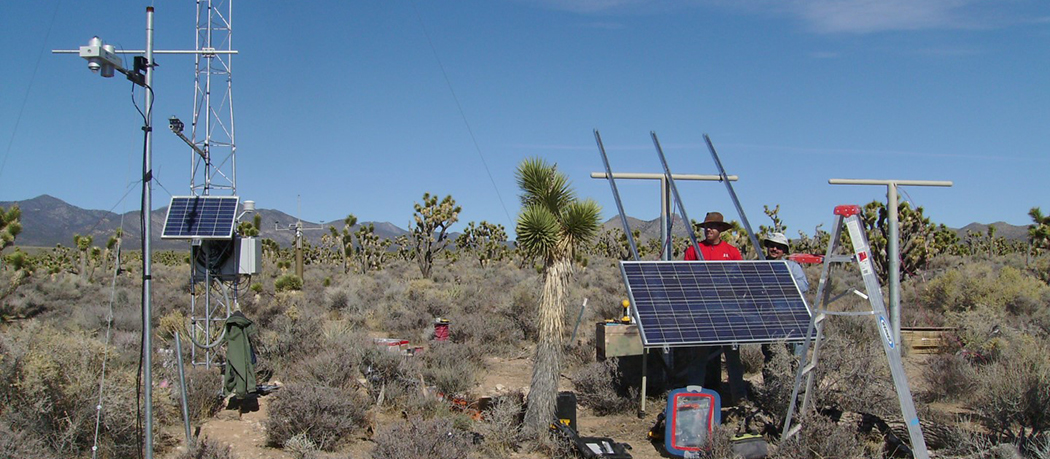An ancient forest of mature pine trees, standing upright under 100 feet of water in a small lake in the Tahoe Basin, helps scientists as they study how changing climate can affect mountain environments and the communities in them. The trees, discovered and studied by a University of Nevada, Reno, researcher, are remnants of a 200-year-long medieval drought.
The site is a stop on one of the field trips of a four-day international conference on mountain observatories held at the University of Nevada, Reno July 16-19.
More than 170 scientists from Asia, Europe, Africa, South America and the United States came to Reno to discuss global monitoring systems for mountain environments, with the goal to move toward a more comprehensive global mountain observation network by strengthening the ties between existing observation systems.
"The importance of mountain environment systems drives our economy, here along the Truckee River from Lake Tahoe to Pyramid Lake, just like it does in communities around the world," said Kevin Carman, provost and professor of biology at the University of Nevada, Reno, in his welcoming remarks at the conference. "Monitoring the snowpack, for example, is imperative to knowing how much water we have, which is true in all mountain areas all around the world."
One could say environmental monitoring on a large scale started in 1905, on the flanks of the 10,700-foot elevation Mt. Rose overlooking Lake Tahoe and Reno, with the first snow survey system by University of Nevada, Reno professor James Church. He was interested in determining how much snow run-off would supply water to the Reno and northern Nevada area. The survey extended across the Sierra, which now helps forecast water supply for California, including domestic uses and the important agricultural industry in California's central valley.
Church's methods were adopted around the world, and he himself set up monitoring systems in the Andes, the Himalayan Mountains and Europe.
"The snow observatory and surveys on Mt. Rose still continue, and are part of a tradition of field observatories here in Nevada," said Franco Biondi, professor of geography at the University of Nevada, Reno and co-organizer for the conference. "Methods developed by Church are still used today in snow surveying and field observatories around the world. In fact, one of our field trips this week is to the snow observatory on Mt. Rose."
The conference, "Mountain Observatories - A Global Fair and Workshop on Long-Term Observing Systems of Mountain Social-Ecological Systems," is organized by the Mountain Research Initiative (MRI) at the Institute of Geography in Bern, Switzerland, in partnership with the University's Extended Studies program and the DendroLab, which is run by Biondi in the College of Science.
"This is different than a typical conference, because in addition to the field trips, and some traditional format such as keynote speakers, there are workshops and roundtable discussions to compare projects, instrumentation and systems," Biondi said. "This is not the first time scientists will be getting together to talk about mountain observing systems, but it is new on this scale.
"MRI chose to have this meeting here because of the University's tradition of field work and research, the innovative observation systems that were recently put in place, and the variety of ecological and social interactions in the region."
Biondi currently oversees four National Science Foundation-funded research projects, and he was the statewide lead for the Ecological Change component of a multi-institutional collaboration funded by the National Science Foundation for $15 million over five years that established a comprehensive environmental monitoring system across the Great Basin of Nevada through the Nevada Climate Change Portal.
The Nevada Climate-ecohydrological Assessment Network, known as NevCAN, includes a dozen environmental monitoring stations in two large ecosystems within the Great Basin, the Sheep Range in southern Nevada and the Snake range in the eastern part of central Nevada. Data is gathered on weather, snowpack, vegetation, soil moisture, solar radiation, with web cameras to capture images in real time. All this information is transmitted in real time over a closed network back to the data portal developed by the University's cyberinfrastructure group to be displayed and archived for both scientists and the general public.
The Climate Change Portal is operated in a collaborative effort with other Nevada higher education institutions, the Desert Research Institute and the University of Nevada, Las Vegas.
The conference isn't just about hydrology or climatology or ecology. Sociologists, political scientists, economists and anthropologists are attending, and helping make the important connection between the environment, land use and social impacts and changes in mountain environments. Derek Kauneckis, professor in the political science department at the University of Nevada, Reno, led two workshop sessions about building societal resilience and adaptive capacity in mountain systems.
"This is a complicated event, it's a big challenge to grapple with the issue of global observatories, especially when we bring in the social impacts," Greg Greenwood, director of MRI, said. "That's what this meeting is all about. The more we build systems, and have meetings like this, the more we understand the social and environmental impacts in mountain systems."
The event featured six keynote speakers on topics including an overview of the relationship of human-environment interactions and best methodologies for observation; data management and sharing; new opportunities for monitoring weather and weather-related phenomena; climate effects on plant and animal populations; and community behaviors in an impacted mountain ecosystem.
Once researchers come together to exchange ideas, and see what other monitoring networks offer, they can develop common programs, assess priority locations and develop creative financing options.
"The synthesis portion of the workshop is perhaps the most important part of the conference," Greenwood said. "We put together all we've shared during the meeting and work towards our goal of building a global network for environmental and social monitoring. It's a great step towards building a global network."











